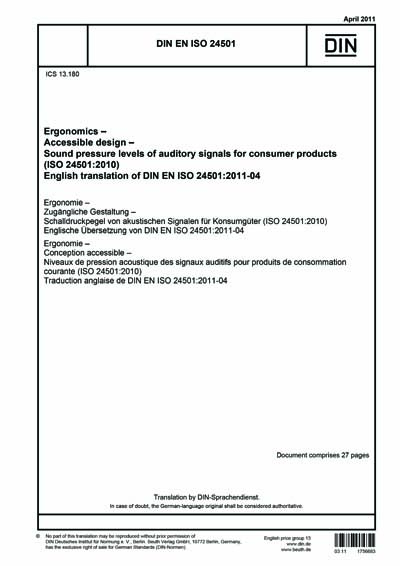Most recent
DIN EN ISO 24501:2011
Ergonomics - Accessible design - Sound pressure levels of auditory signals for consumer products (ISO 24501:2010); German version EN ISO 24501:2010
This Standard specifies methods for determining the sound pressure level range of auditory signal so that the users of consumer products, including elderly people with hearing loss which develops during ageing, can hear the signal properly in the presence of specific interfering sounds. When an auditory signal with a fixed sound level is used, the level shall be adjusted to fall in the range. When the sound level is controllable by the user, the level shall be variable to cover the entire range at the narrowest. Auditory signals, in this Standard, refer to sounds with a fixed frequency (also called beep sounds). Electronic chimes and voice guides are not included. NOTE It is also recommended that this document be used when variable frequency sounds or melodic sounds are used. This Standard is applicable to auditory signals which are heard in the same room where the product is used or in an adjacent room not entirely enclosed within walls (at approximate maximum distance of 4 m from the product). It is not applicable to auditory signals heard through a head receiver or earphones, or to those heard with the ear located near the sound source. This Standard does not specify the sound pressure level of auditory signals regulated by other statutes such as those for fire alarms, gas leakages, and crime prevention, nor does it specify auditory signals peculiar to a communication tool such as telephones.*People conduct their daily lives surrounded by various consumer products, for instance, home electrical appliances, information and telecommunication products, automatic office equipment, gas-heating equipment, toys, sanitary equipment, and health-care products, all of which use auditory signals. These auditory signals can be indistinct because of the hearing loss which occurs with ageing or because of interfering sounds in the surroundings. This International Standard specifies methods for determining the sound pressure level range of auditory signals so that the users of consumer products, including people with age-related hearing loss, can hear the signal properly in the presence of interfering sounds. Auditory signals, in this International Standard, refer to sounds with a fixed frequency (also called beep sounds) and do not include variable frequency sounds, melodic sounds, or voice guides. This International Standard is applicable to auditory signals which are audible in the same space in which the product is used or in an adjacent space which is not entirely enclosed by walls (maximum distance of 4 m from the product). It is not applicable to auditory signals heard through earphones or to those heard with the ear located very near to the sound source (for instance, cameras held at eye level). This International Standard does not specify the sound pressure level of auditory signals regulated by other statutes, such as those for fire alarms, gas leakages and crime prevention, nor does it specify auditory signals particular to a communication tool such as telephones. It does not specify auditory danger signals for public or work areas which are covered in ISO 7731, ISO 8201, and ISO 11429. This International Standard specifies methods for determining an appropriate sound level range of auditory signals, so that all product users, including people with age-related hearing loss, can hear them properly against interfering sounds. This sound level range specification was determined based on results of experiments in which people of all ages participated. Auditory signals whose sound pressure level is in that range are expected to be audible and comfortably loud for most users in the presence of interfering sounds. This International Standard should be applied as appropriate to products, depending on the product type and the conditions of use. It does not apply to machines and equipment used for professional work. This International Standard adopts the principles of accessible design given in ISO/IEC Guide 71.
Content Provider
Deutsches Institut für Normung [din]






